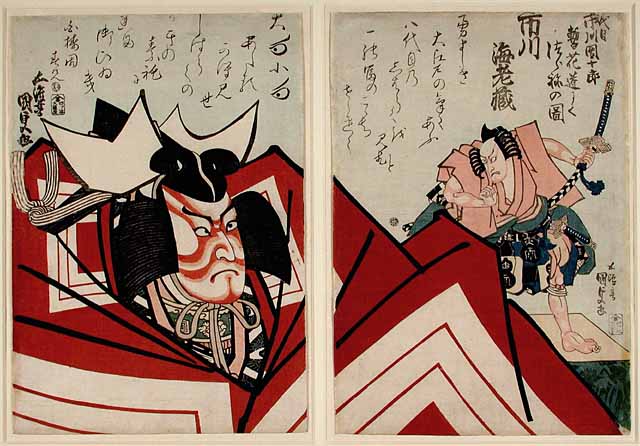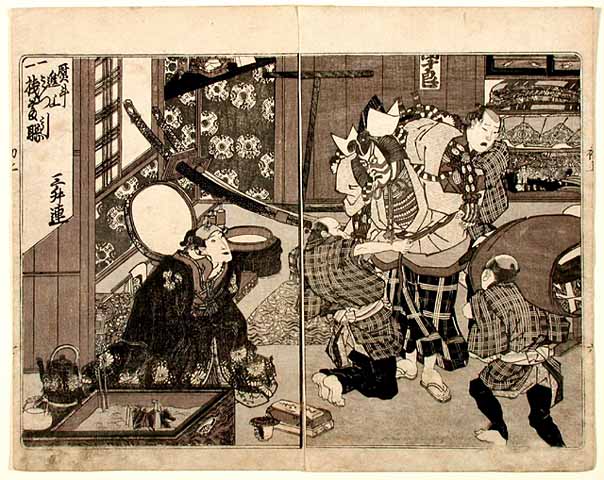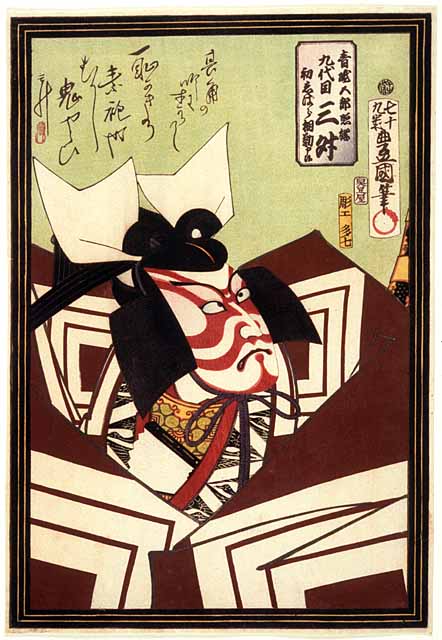
Ichikawa Danjuro VIII as Kamakura Gongoro in Shibaraku! (Stop Right There!) with Ichikawa Ebizo V (formerly Danjuro VII) in the background as the villain Narita Goro. circa .1836 Private collection
This diptych commemorates the debut of Danjuro VII’s eldest son in the central role of this play. The role is one of the great examples of the ‘rough-stuff’ style (aragoto) for which the Ichikawa line of actors was famous. Danjuro VIII is striking a defiant pose on the raised passageway (hanamichi) leading from the back of the theatre through the audience to the main stage, while his father, playing the role of the villain, looks on from the main stage. This is the great moment when Narita Goro, on the point of executing the innocent Yoshitsuna and his fiancee, is halted by the powerful voice of Gongoro coming from the rear of the theatre shouting ‘Shibaraku! Shibaraku!’ (‘Stop right there!’).
The hero then strides onto the hanamichi wearing the most extravagant aragoto costume: a voluminous suo (‘plain sliding-door’) robe, with the Danjuro mon adorning square sleeves so wide that they have to be supported with splints. Laudatory poems fill the space above the figures. This impression, the only known surviving example of this diptych, has faded: the thick cord around Danjuro VIII’s neck was originally bright red, and the thin cord was purple.

Yakusha kijinden Biographies of eccentric actors
Page from the book of this title, printed from woodblocks, 1833
Private collection
Ichikawa Danjuro VII is revealed here in his dressing room, chatting with the female-role actor Segawa Kikunojo V. Three assistants are dressing Danjuro in the bulky costume of the lead role of Kamakura Gongoro in Shibaraku! (Stop right there!). He has already put on the elaborate make-up required for the role. Two servants struggle to tighten his armour and jacket, while another servant on the right brings in the giant trousers (hakama). The great eight-foot sword that he will carry over his shoulder is seen resting against the wall behind him.
This book appeared in four volumes and provided meticulously rendered views of actors on and off stage, with a text discussing leading actors and their predecessors. It is remarkable for its restrained yet rich palette. A book like this would cost considerably more than a single-sheet colour print. It was intended for the wealthier connoisseurs of the Kabuki theatre.

Ichikawa Sansho (Danjuro IX) as Aoito no Goro Terutsuna in Shibaraku! (‘Stop right there!’)
12/1864
Given by the Friends of the Fitzwilliam with the aid of the MGC Purchase Grant Fund and the National Art Collections Fund.
Published shortly before Kunisada’s death, this print is signed Shichijukyu-sai Toyokuni hitsu (‘from the brush of the seventy-nine-year-old Toyokuni’). A poem in the actor’s own hand is printed at top left, signed with his poetry name, Sansho.
Kunisada had depicted successive generations of the Ichikawa lineage of actors in the role of Gongoro in Shibaraku!, which was one of the great examples of the ‘rough-stuff’ style (aragoto) for which the Ichikawa line of actors was famous. All of Kunisada’s prints depict the moment of the character’s entrance, one of the highpoints of all kabuki. Narita Goro is on the point of executing the innocent Yoshitsuna and his fiancee, when the voice of Gongoro comes from the rear of the theatre shouting ‘Shibaraku! Shibaraku!’ (‘Stop right there!’). The hero then strides onto the hanamichi passageway leading through the audience, wearing the most extravagant costume: a voluminous suo (‘plain sliding-door’) robe, with the Ichikawa crest (mon) of triple-rice-measures (mimasu) adorning square sleeves so wide that they have to be supported with splints.
Collections Record: P.91-1999



